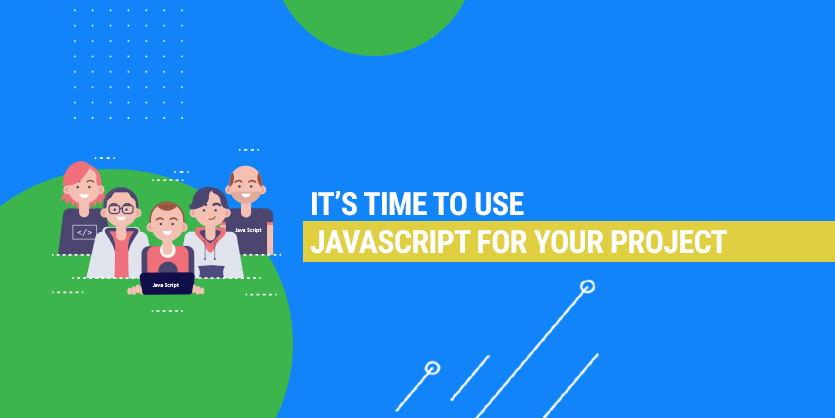
The major technology that is used for developing applications that you can see in any browser is JavaScript. It’s a programming language that was set to one single standard ECMAScript. It’s proliferant and it’s very popular around the globe these days. Take a look at what kind of projects you can use JavaScript for:
- Mobile apps with React Native;
- Safari, Opera, and Chrome extensions;
- MongoDB and similar databases;
- Scripts for LibreOffice, Unity, OpenOffice or Adobe CS;
- Google Desktop Gadgets, Yahoo! Widgets, Microsoft Gadgets or Apple Dashboard Widgets;
- And much more.
JavaScript has made a super great impact on the world of programming and it’s still becoming more and more popular. You can check the Github report regarding the languages that have the biggest number of open source contributions. This language has been developing and implementing new standards. Now we have ES2017. JavaScript has a high chance to keep its position in the future.
The stack
It has everything that you may need for developing a web application. MEAN stack is one of the most commonly used. It means the use of MongoDB, Express, AngularJS, and Node.js. But you are not limited to these technologies only. It’s good to be good at several stack versions. Let’s take a look at the most wanted combinations below.
Node.js + Express for the back-end
The goal of the technology is to make data transfer and implementation of all the required functions of the server side. Node.js is based on V8 JavaScript Engine. Node.js cannot use threads, but you can get the most out of creating child processes that are additionally supported by clusters.
Express is often used with Node.js as it’s a super great tool thanks to a big number of bridges between the OS and the database and so on.
React + Redux for the front-end
Facebook is a creator of React that acts out as a JavaScript library. You are free to use this technology for developing different visual interfaces for the web. If you take a look at Model-View-Controller pattern, you will find it in the V place. You can combine its features with Redux or even AngularJS.
React Native for the mobile
Use it for developing applications for mobile devices. You can use it for iOS and Android as well. There are some strong sides that we can even call as benefits like no need to recompile the code, reload the device all the time or hot reloading that adds a new part of the code but keeps the current state of the app. It’s not a good choice for battery and memory consuming applications.
MongoDB for the database
You will find JSON-like documents in the NoSQL system that we name as MongoDB. You can freely use JavaScript for queries. The format of the documents allows it perform all the processes fast. You can use it for several servers thanks to the sharding technology to level the load. MongoDB comprises replication systems for the automated fall-backs to replicas if any failure occurs.
Technology
How does JavaScript differ from other programming languages? Take a look below.
Prototypal inheritance
Let’s consider the model of inheritance for JavaScript as a prototypal inheritance. You can observe it since the ES2015 was established to add the class keyword to JavaScript. How does it look like in reality? An object can inherit from another object without any additional classes and it becomes a prototype of the former object. This is the major difference of this type of inheritance from the classical one where you will have so-called blueprints that stand for classes.
You won’t find extended classes in JavaScript as it has prototype chains instead of them. There’s no support for a multiple inheritances when we are talking about one level of the parent. A concatenative inheritance will help you use multiple inheritances with no pitfalls.
Functional code
It’s super great that you can use JavaScript for both Functional and Object-Oriented code. You can do whatever you want with the functions as if they were any other values thanks to their super role. You can do because there are specific concepts regarding lexical scopes and closures that preserve the state of the internal function even in the case when the outer scope or scopes finish.
Asynchronicity
You will not see anything related to the multi-threading when using JavaScript instead of other popular languages. You will have a chance to use Event-Loop and see how child processes and web workers provide you with a good performance. A good thing here is that you will not suffer from any performance problems as there won’t be any troubles with handling great numbers of threads. You will avoid IO-blocking that can lead to terrific consequences like ruining the UX completely.
Variadic functions
If you need to check the function or its components, you can take the exact number of them and see how they work, There’s no need to run the checkups for the parameters of the whole function. You won’t find this feature in most of the other languages.
To conclude
JavaScript is one of the most common languages for developing various applications around the globe. It will keep its position for a long time in the future. We advise you to start using it if you haven’t done this before.
How to conduct an interview with a JavaScript developer?
The popularity of responsive and full-featured applications has made JavaScript a handy tool for developing them. You get a great code that is delivered to you by a pro developer. So having such a person on your team will let you create a project that you wish. However, the process of choosing the right candidate for a position can be a tough task.
We’re giving you some practical tips on how to conduct an interview and define whether this very candidate fits the position. You can use the tips for hiring a front-end, back-end or full-stack developer. It’s not enough to turn symbols into lines of the code. You will need someone who can turn your ideas into some specific language syntax. What can you do within 20-30 minutes of the interview?
Define the level of expertise
The thing to focus on when interviewing is JavaScript chops and not some check-ups whether the candidate knows some basic coding. Take one general question and make every new question a bit more narrow and complicated until you see that the candidate cannot give you the answer. Don’t worry if the candidate has more experience in using other languages for the previous projects.
Find the drawbacks
Give the candidates some pieces of the code and ask them what they think about it if there are any drawbacks and how they would improve it. The candidates should be able to explain how the code will work, predict the outcome in case the errors are not fixed and so on.
Finish a simple task
The worst variant of performing this task is writing the code on a paper or on the board. However, there are some companies that require the candidates do this on the board. You can ask the candidates to perform this task during the interview or prepare it in advance if it may require too much time to finish.
View the portfolio
The last stage of the interview is analyzing the portfolio. It doesn’t have to be a static presentation of the projects. You will probably get the links to open source contributions or some past projects. Take a look at them and ask questions regarding the technologies used, some problems that the candidates had to solve and so on.
The finish line
If you are not aware of JavaScript, we recommend you to take someone who is good at it to be able to evaluate the answers of the candidates the right way. Communication matters, so watch how the candidates perceive what you say to them and how they react. If you feel that your conversation is easy to keep on and you get clear answers to all of your questions, you probably see the best candidate for the position of a JavaScript developer.





